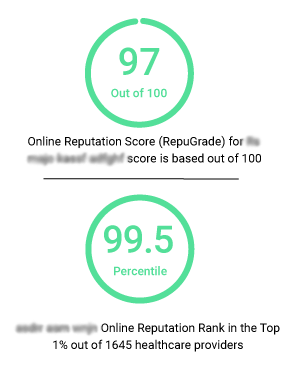5 Online Marketing Methods for a Healthy Relationship with Your Patients

A greater patient engagement is a win-win situation for both, the patient and the provider. For patients, it contributes to improved health outcomes, and for providers, it ensures a better reputation among their patients which also increases patient referrals for them. And, with 52 millions of US adults going on web to search for health and medical information, you can't miss the opportunities that online healthcare marketing offers for connecting and developing a strong and healthy relationship with your patients. So, how can you actually do that? Improving on patient-provider communication, which is also an integral part of patient care, is the only way to promote patient engagement. You need to fill the communication gap that oftentimes occurs once your patients leave your office and till they visit again. By opening a direct line of communication for your patients to let them interact with you on their health and medical issues, you can earn their trust in you, thereby building a strong and healthy relationship with them. Thanks to the various innovations in information technology, and to the possibilities of online healthcare marketing, you can easily establish that line of communication with your patients. Here are the 5 online methods that you can implement in your practice's healthcare marketing strategy to start building a positive, healthy, and fruitful relationship with your patients: “The online healthcare marketing strategy must be in compliance with HIPAA rules and regulations. This is more so important when it involves communicating and interacting with your patients. Always take care that none of your patient-provider communicating activities should be, by any means, a direct violation or breach of HIPAA guidelines.”
-
Patient Portal
This is a very new strategy that doctors are now adopting increasingly to communicate with their patients and even give them a 24-hour access to their health records. This is like giving your patients a direct access, through a log in Id and password, to a database that keeps a record of everything, a record of various diseases they acquired overtime, the medications and treatment they underwent, and the precautions and advises to be followed. However, the biggest benefit that it serves is facilitating a direct interaction between patient and provider through a messaging platform, where your patients can directly communicate with you for gaining relevant health information. For example, if a patient has a question about a medication that he or she is taking, the portal makes it easy to get an answer right away. A portal also encourages your patients to become more active participants in their health by making care plans accessible, in addition to patient education resources and tools. It also allows them to document health tasks and track progress meeting their goals. Patient engagement is all about actively involving them in their health outcomes by promoting collaboration, education, feedback, and understanding, which is easily possible through a healthcare portal DO NOT inquire about any personal topics that has nothing to do with your patient's health. (Even though that's not a problem during an appointment) Keep your interaction and the topic of your discussion solely on the health condition and prognosis. -
Personal Interaction
Your patients spend a great amount of time on social media websites like Facebook, Twitter, etc., interacting among themselves for sharing information on health issues. This is an opportunity for you to engage them by talking to them about important health issues and be a leader in the community. However, you should strict your role on social media for sharing information, medical education, health advocacy, and changes in the industry. Here's how you can engage your existing as well as prospective patients on major social media platforms:Twitter
- Tweet about an important medical conference you are about to attend to keep your community members informed.
- You can also tweet about any important change in the industry, its laws, or about an innovation in the treatment procedure.
- Tweeting a blog post related to an important health issue, or a news article covering great health related topics from around the world story, etc.
- Hosting a Twitter chat on a trending medical or health related topic is another way for greater patient engagement. This allows your patients a more real-time interacting experience with you. (Never entertain on or inquire about any personal information related to you or your patient)
Facebook
- Create a Facebook fan page for your practice and keep posting interesting pieces of content such as blog posts, articles, infographics, or video content related to important medical and health issues.
- You can also comment on the inquiries or suggestions of your patients, but try posting only general comments, and not answering to particular individual patient's questions.
- For marketing your practice, use your fan page (in your name or your practice's name) instead of your personal account. Because a fan page operates solely on “likes”, it avoids many risks of HIPAA violation by indicating that someone wants to receive more information from the person or practice.
-
Email Campaigns
Email campaigns are a great healthcare marketing method for patient engagement and relation building with them. You can mail your patients about an event you are organizing for patient-physician meet up, or mail newsletters to those who have already subscribed for it. Newsletters allow you to build a relationship with your patients beyond their regular visit and serve as an additional opportunity to share the message of how much you appreciate their business, and the referrals of their friends and family. Email campaigning lets you interact with your patients one-on-one. However, sending them requires your patient's approval or subscription to it in some way or other. DO NOT send mails to your patients who haven't subscribed for it. For subscribers, don't over-send that it starts bothering them. -
Physician Website
Having a website for your practice lets your prospective and existing patients connect with you in a more showful way. It lets them research about your practice and contact you when they want a medical or healthcare service. On your website, you display your specialty, background, and services that works by providing a good first impression about you and your practice to your first-time visitors. That 'good first impression' is the first hurdle that you should overcome for building a future patient-provider relationship. To let your patients know you even better, put your medical specialty and background on your website with more emphasis and clarity. It will give your patients a good overview of you as a doctor. You can also post articles related to your specialty or services you provide, for a better connect. DO NOT divulge very personal information as it can offer effective insight into your private life. Also, do not share irrelevant pictures related to you, your service, your patients, etc., as they could not only divert your patient's attention, but also violate or breach HIPAA guidelines. -
Online Reviews
Gathering positive online reviews for your practice can go a long way in building a positive relationship with your prospective as well as your existing patients. Positive reviews aren't just loved by your patients but by Google too, and when Google starts noticing your practice, patients start lining up for you. With online review management software, you can easily gather, manage, and show to others positive online reviews about your business. Do Not just respond thankfully to the positive reviews, but also respond tactfully to the negative ones. By tactfully, we mean replying by asking what went wrong for showing your willingness to learn about it and rectify it.
Conclusion
Medical marketing deals with a very sensitive audience. It's vital to personally connect with the patients and make them feel that they are important. The era of digitization and the major media shift has come out as sheer blessing for the healthcare marketers. It was never so convenient for the doctors to directly communicate and build a rapport with their patients. With a robust healthcare digital marketing strategy, healthcare professionals and medical institutions have an opportunity to retain their existing patients for a lifetime.
Comments are closed


